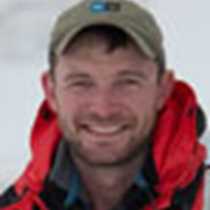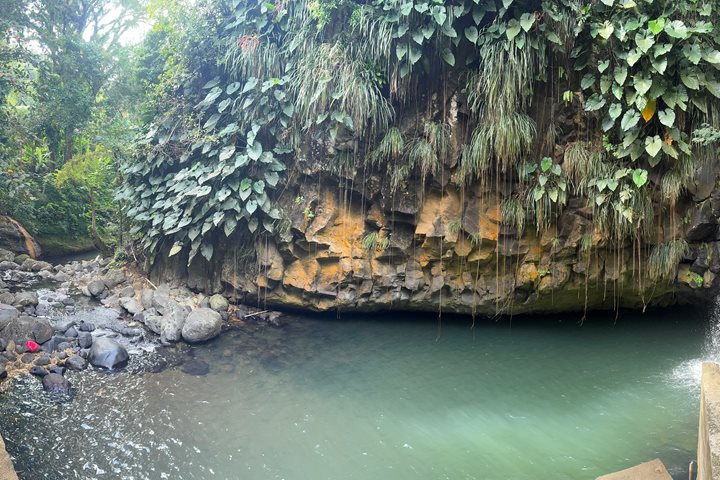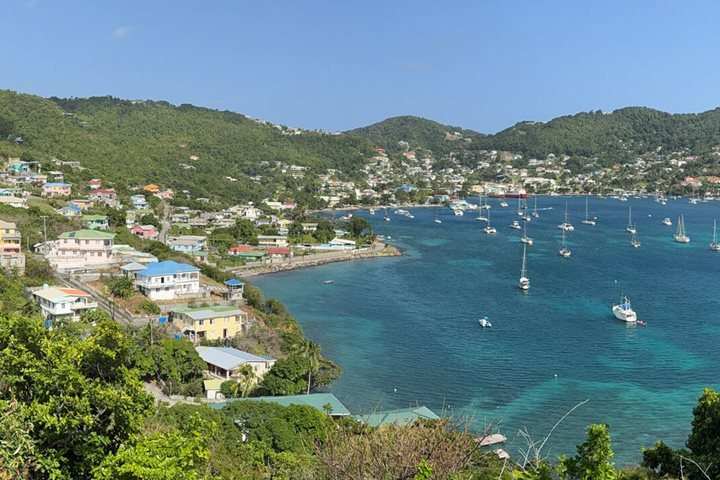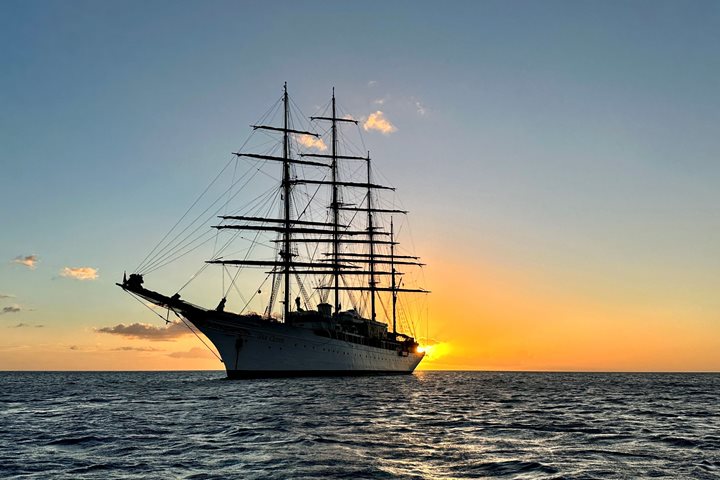Sunrise at 6:04 over the mountains of St. Vincent the largest island and capital of the Grenadines. By 7 we were motoring the channel (4.5 miles wide) separating St. Vincent on our port from the more southerly Bequia on our starboard. We were making 4 knots. The wind about 15 knots was in an easterly direction and our heading was 112. The temperature was a delightful 28c or 82f. Brown boobies were flying just over the tops of the waves looking for an unwary fish for breakfast. A frigate bird was circling about 100’ over our main mast. These are most “prehistoric” looking of birds but great soarers. Sailors went aloft at 8. By 11 we had a 20-knot wind and we had a heading of 355. Our captain decided to set the skysails – not an easy task in a 20-knot wind and we were scudding along at 6.5 knots. Ian went up on the fos’cle at 11:30 with guests for a great photo opportunity. Tom Heffernan gave a lecture on the Rastafarian religion at 9:30.
We tendered ashore in the afternoon into the small charming town of Port Elizabeth. Bequia was settled first by the Taino and then Carib Indians. Scots were bought over quite early as indentured servants in some considerable numbers in the early 18th century and they have remained here. There are few surnames on the island, e.g., Gooding, Davis, and Olivier. The demographics of Bequia, although overwhelming Afro-Caribbean, are unlike many of the other islands we have visited as it does have a substantial Euro-American population. Like all the islands we have visited, however, the races did mix and there is now a rainbow of racial colors all living harmoniously. These European indentured servants worked on the early sugar plantations. When they came here there was still a small relic population of Caribe Indians on the island. These original settlers who emigrated up from the Orinoco basin centuries earlier had already begun to mix with the African population also brought to work the sugar plantations. The largest of these plantations were located on the east side of the island, near Industry Bay. The people who resulted from this Caribe/African mix were called “Garafuna,” or sometimes “Black Caribe.” I cannot testify to my following etymology but it sounds to me as if the word “Garafuna” may be a dialect expression of “Caribe-fumé” with “fume” suggesting the darkening of the skin when the races mixed.
There was a Black Caribe revolt against the English overlords in 1795 and the English executed one of the great Caribe chiefs, Joseph. At one point in 1795 the “Garafuna” controlled the entire island of St. Vincent for almost six months. They were finally beaten and approximately 5 thousand Garafuna were rounded up and sent to a small-uninhabited isle called Balinceaux just off the south-east coast of Bequia. They remained there until 1798 when the survivors were resettled in Honduras and Belize. Today some of their descendants make a pilgrimage to Bequia in memory of their ancestors.
Tom Heffernan led a walking tour of the town stopping and the remarkable boat builder and model boat museum, the Rastafarian market, and selected shops along the way. I saw one happy guest take home a great model of a whaling skiff. Some of our guests took the scenic coastal walk “Belmont Walk” to reach our final destination on the island, “Jack’s Place.” This famous place sits directly on Princess Margaret Bay and has to be one of the most idyllic spots in all the Caribbean. There we enjoyed all sorts of fruit punches and some I am told had rum in them! The water in the bay was just right, neither too cold nor hot, and the color a clear crystalline coral blue crystalline blue. The sand is almost crystalline white. I swam out about 400 yards and still could easily see the bottom 25 feet below. Tonight, we had a fabulous Caribbean barbeque on the Lido Deck. After dinner our old friends from Bequia, “the Kings of String” came aboard and played fabulous local music. They played until 10AM and had us up on our feet singing and dancing!









